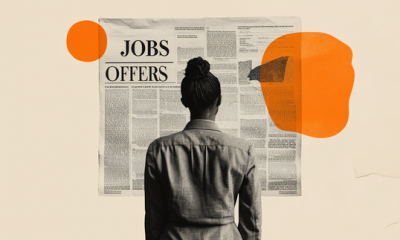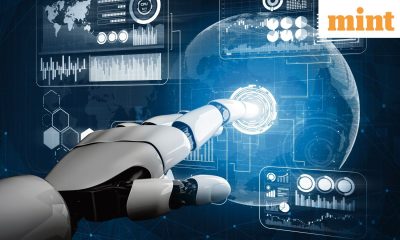

Metaverse
AI holds tantalising promise for the emerging world – Crypto News
New technology brings with it both the sweet hope of greater prosperity and the cruel fear of missing out. Satya Nadella, the boss of Microsoft, says he is haunted by the fact that the Industrial Revolution left behind India, his country of birth. (Indian manufacturers hardly enjoyed a level playing-field—Britain was then both their rival and their ruler.) Many technologies, such as online-education courses, have generated more hype than economic growth in the emerging world. Some people worry that generative artificial intelligence (AI), too, will disappoint the global south. The big winners so far seem to be a bunch of Western early adopters, as well as startups in San Francisco and America’s “magnificent seven” tech firms, which include Microsoft and have together added an astonishing $4.6trn to their market value since Chatgpt’s launch in November 2022.
Yet AI stands to transform lives in the emerging world, too. As it spreads, the technology could raise productivity and shrink gaps in human capital faster than many before it. People in developing countries need not be passive recipients of AI, but can shape it to suit their own needs. Most exciting of all, it could help income levels catch up with those in the rich world.
The promise of AI in developing countries is tantalising. As in the West, it will be a useful all-purpose tool for consumers and workers, making it easier to obtain and interpret information. Some jobs will go, but new ones will be created. Because emerging countries have fewer white-collar workers, the disruption and the gain to existing firms may be smaller than in the West. The IMF says that a fifth to a quarter of workers there are most exposed to replacement, compared with a third in rich countries.
But a potentially transformative benefit may come from better and more accessible public services. Developing economies have long been held back by a lack of educated, healthy workers. Primary-school teachers in India have twice as many pupils as their American counterparts, but are ill-equipped for the struggle. Doctors in Africa are scarce; properly trained ones are scarcer. Whole generations of children grow up badly schooled, in poor health and unable to fulfil their potential in an increasingly global labour market.
As our briefing this week sets out, policymakers and entrepreneurs around the world are exploring ways that ai can help. India is combining large language models with speech-recognition software to enable illiterate farmers to ask a bot how to apply for government loans. Pupils in Kenya will soon be asking a chatbot questions about their homework, and the chatbot will be tweaking and improving its lessons in response. Researchers in Brazil are testing a medical ai that helps undertrained primary-care workers treat patients. Medical data collected worldwide and fed into AIs could help improve diagnosis. If AI can make people in poorer countries healthier and better educated, it should in time also help them catch up with the rich world.
Pleasingly, these benefits could spread faster than earlier waves of technology. New technologies invented in the early 20th century took more than 50 years to reach most countries. By contrast, AI will spread through the gadget that many people across the emerging world already have, and many more soon will: the phone in their pockets. In time, chatbots will become much cheaper to provide and acquire.
Moreover, the technology can be tailored to local needs. So far there is little sign that AI is ruled by the winner-takes-all effects that benefited America’s social-media and internet-search firms. That means a variety of approaches could prosper. Some developers in India are already taking Western models and fine-tuning them with local data to provide a whizzy language-translation service, avoiding the heavy capital costs of model-building.
Another idea that is also taking off in the West is to build smaller, cheaper models of your own. A narrower set of capabilities, rather than the ability to get every bit of information under the sun, can suit specific needs just fine. A medical ai is unlikely to need to generate amusing limericks in the style of William Shakespeare, as ChatGPT does so successfully. This still requires computing power and bespoke data sets. But it could help adapt ai in more varied and useful ways.
Some countries are already harnessing ai. China’s prowess is second only to America’s, thanks to its tech know-how and the deep pockets of its internet giants. India’s outsourcing industry could be disrupted, as some back-office tasks are taken on by generative ai. But it is home to a vibrant startup scene, as well as millions of tech developers and a government that is keen to use ai to improve its digital infrastructure. These leave it well-placed to innovate and adapt. Countries in the Gulf, such as the United Arab Emirates and Saudi Arabia, are determined to build an ai industry as they shift from oil. They already have the capital and are importing the talent.
Each country will shape the technology in its own way. Chinese chatbots have been trained to keep off the subject of Xi Jinping; India’s developers are focused on lowering language barriers; the Gulf is building an Arabic large language model. Though the global south will not dislodge America’s crown, it could benefit widely from all this expertise.
Teaching AId
Plenty could yet go wrong, obviously. The technology is still evolving. Computing power could become too expensive; local data will need to be gathered and stored. Some practitioners may lack the ability to take advantage of the knowledge at their fingertips, or the incentive to try new things. Although countries in sub-Saharan Africa stand to gain the most from improvements to human capital and government services, the technology will spread more slowly there than elsewhere without better connectivity, governance and regulation.
The good news is that investments to speed AI’s diffusion will be richly rewarded. Much about the ai revolution is still uncertain, but there is no doubt that the technology will have many uses and that it will only get better. Emerging countries have suffered disappointments before. This time they have a wonderful opportunity—and the power to seize it.
© 2023, The Economist Newspaper Limited. All rights reserved.
From The Economist, published under licence. The original content can be found on www.economist.com
-

 Cryptocurrency1 week ago
Cryptocurrency1 week agoIlluminating progress: Is a $140K income ‘poor’? – Crypto News
-
Technology6 days ago
Crypto Lawyer Bill Morgan Praises Ripple’s Multi-Chain Strategy as RLUSD Hits $1.1B – Crypto News
-

 Blockchain5 days ago
Blockchain5 days agoAnalyst Reveals What You Should Look Out For – Crypto News
-

 Technology1 week ago
Technology1 week agoSamsung Galaxy S25 Ultra 5G for under ₹80,000 on Flipkart? Here’s how the deal works – Crypto News
-

 others7 days ago
others7 days agoGold holds strong at $4,200 as Fed-cut anticipation builds – Crypto News
-

 Cryptocurrency1 week ago
Cryptocurrency1 week agoUK recognises crypto as property in major digital asset shift – Crypto News
-
others1 week ago
Bitcoin Price Forecast as BlackRock Sends $125M in BTC to Coinbase — Is a Crash Inevitable? – Crypto News
-

 Cryptocurrency7 days ago
Cryptocurrency7 days agoCrypto Holiday Gift Guide 2025 – Crypto News
-
others5 days ago
Breaking: Labor Department Cancels October PPI Inflation Report Ahead of FOMC Meeting – Crypto News
-

 Cryptocurrency5 days ago
Cryptocurrency5 days agoArgentina moves to reshape crypto rules as banks prepare for Bitcoin services – Crypto News
-

 Blockchain4 days ago
Blockchain4 days agoStripe and Paradigm Open Tempo Blockchain Project to Public – Crypto News
-

 Technology1 week ago
Technology1 week agoWorking on a screen all day? These 8 LED monitors in Dec 2025 are kinder on your eyes – Crypto News
-
others1 week ago
Morgan Stanley Turns Bullish, Says Fed Will Cut Rates by 25bps This Month – Crypto News
-

 Cryptocurrency1 week ago
Cryptocurrency1 week agoFlorida Appeals Court Revives $80M Bitcoin Theft – Crypto News
-

 Blockchain4 days ago
Blockchain4 days agoBMW Helps JPMorgan Drive Blockchain-Based FX Payments – Crypto News
-

 Cryptocurrency1 week ago
Cryptocurrency1 week agoBTC staking platform Babylon teams up with Aave for Bitcoin-backed DeFi insurance – Crypto News
-

 Blockchain1 week ago
Blockchain1 week agoSolana (SOL) Cools Off After Rally While Market Eyes a Resistance Break – Crypto News
-
others1 week ago
XRP Price Prediction As Spot ETF Inflows Near $1 Billion: What’s Next? – Crypto News
-

 others1 week ago
others1 week agoThe rally to 7120 continues – Crypto News
-

 Blockchain7 days ago
Blockchain7 days agoBitcoin Buries The Tulip Myth After 17 Years: Balchunas – Crypto News
-

 Cryptocurrency6 days ago
Cryptocurrency6 days agoWhy Ethereum strengthens despite whale selling – Inside Asia premium twist – Crypto News
-

 others6 days ago
others6 days agoNasdaq futures hold key structure as price compresses toward major resistance zones – Crypto News
-

 others6 days ago
others6 days agoNasdaq futures hold key structure as price compresses toward major resistance zones – Crypto News
-

 Blockchain1 week ago
Blockchain1 week agoLedger Finds Chip Flaw Allowing Complete Phone Takeover – Crypto News
-
Business1 week ago
Kalshi, Robinhood and Crypto com Face Cease & Desist Order in Connecticut – Crypto News
-
Business1 week ago
What’s Next for Dogecoin Price After Whales Scoop 480M DOGE? – Crypto News
-

 Cryptocurrency1 week ago
Cryptocurrency1 week agoCoinDCX data reveals India’s rising appetite for diversified digital assets – Crypto News
-

 Technology1 week ago
Technology1 week agoCloudflare Resolved Services Issues Caused by Software Update – Crypto News
-
others1 week ago
Colombia Consumer Price Index (YoY) below forecasts (5.45%) in November: Actual (5.3%) – Crypto News
-
Technology1 week ago
Solana Price Outlook: Reversal at Key Support Could Lead to $150 Target – Crypto News
-

 Technology1 week ago
Technology1 week agoFrom security camera to gaming hub: 6 Easy tricks to make your old smartphone genuinely useful again – Crypto News
-

 others1 week ago
others1 week agoCanadian Dollar soars after upbeat labor report – Crypto News
-
others1 week ago
$1.3T BPCE To Roll Out Bitcoin, Ethereum and Solana Trading For Clients – Crypto News
-

 others6 days ago
others6 days agoStocks survive PCE and consumer data – FOMC too? – Crypto News
-

 Cryptocurrency6 days ago
Cryptocurrency6 days agoThursday links: Prediction markets, agent hackers, quantum risks – Crypto News
-

 Technology6 days ago
Technology6 days agoStarlink India pricing revealed: How much does monthly plan cost and what are its benefits? – Crypto News
-

 Cryptocurrency1 week ago
Cryptocurrency1 week agoCayman Islands sees rising Web3 foundation activity – Crypto News
-

 Technology1 week ago
Technology1 week agoApple Watch’s latest update drops a lifesaving feature for Indian users: here’s how it works – Crypto News
-

 Metaverse1 week ago
Metaverse1 week agoBetter Tomorrow: How OpenAI is reimagining education and inclusion for the digital age – Crypto News
-

 Blockchain1 week ago
Blockchain1 week agoN3XT Launches Blockchain-Powered Bank | PYMNTS.com – Crypto News
-
Business1 week ago
Bitcoin, ETH, XRP, SOL’s Max Pain Price as Over $4B Options to Expire – Crypto News
-
Business1 week ago
Is ZCash Price Set for a Bigger Rally After Its 10% Surge on the Bitget Listing? – Crypto News
-

 Cryptocurrency1 week ago
Cryptocurrency1 week agoGlassnode report reveals Bitcoin’s growing stability amid ETF activity and RWA expansion – Crypto News
-
Technology1 week ago
Peter Brandt Hints at Further Downside for Bitcoin After Brief Rebound – Crypto News
-
others1 week ago
United States Consumer Credit Change came in at $9.18B, below expectations ($10.5B) in October – Crypto News
-

 Technology6 days ago
Technology6 days agoTier 2 and Tier 3 cities drive over 90% of engagement on audio social platforms in India, says report – Crypto News
-

 Blockchain6 days ago
Blockchain6 days agoBittensor Set for First TAO Halving on Dec. 14 – Crypto News
-

 Blockchain6 days ago
Blockchain6 days agoBitcoin Santa Rally Talk Meets Last FOMC of 2025 – Crypto News
-

 Blockchain6 days ago
Blockchain6 days agoEthereum Founder Breaks Silence With Major Upgrade Proposal – Crypto News
-
Business5 days ago
Solana Price Set for $150+ as Bullish Sentiment Rises in Crypto Market – Crypto News














